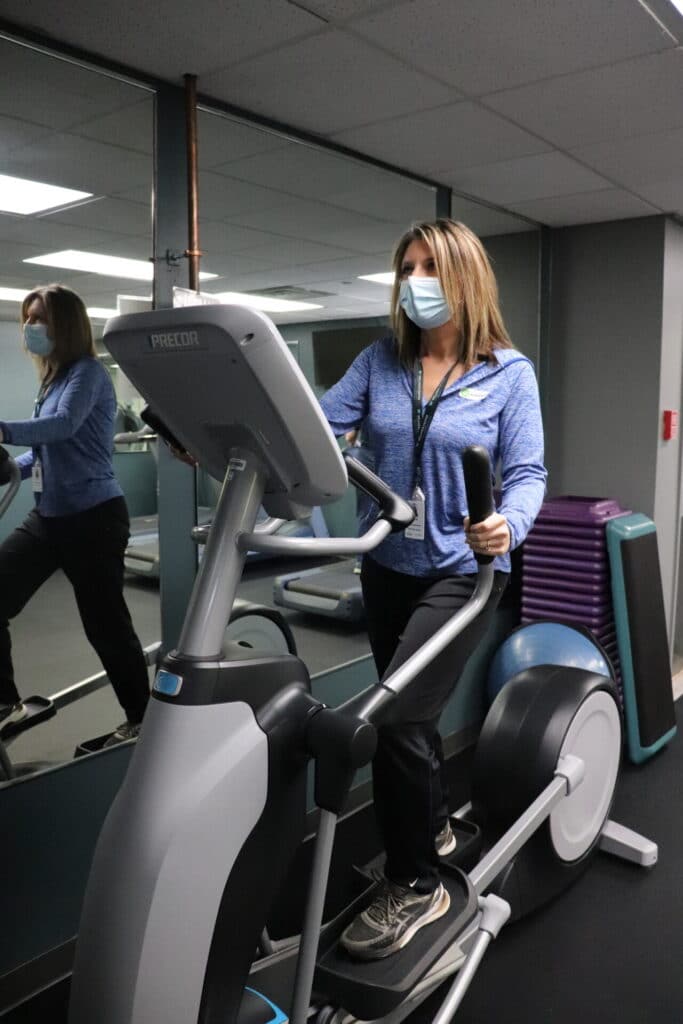The onset of COVID-19 in 2020 caused a change from a fast-paced society, mostly bounded by daily routine, to a world put on hold while simultaneously being left in a state of flux. Gyms and fitness centers, along with countless other businesses, have felt this shift acutely as they have been asked to modify operations repeatedly over the past 11 months. Along with the closures and reopenings, the question that has remained is, “Are gyms and fitness centers safe?”
While some may argue that fitness facilities are high-risk areas for the potential spread of COVID-19, a 2020 study conducted by Fisher et al. found no statistically significant correlation between having visited a fitness facility and then testing positive. In the study, the authors state that the places that pose the highest risk for contracting COVID-19 are going to be settings where physical distancing and mask wearing are not effectively practiced. This would preclude all fitness facilities implementing physical distancing and mask wearing from being considered high-risk settings for transmission (Larcom, 2020).

Luckily, the Wellness Center completed our remodel of the Studio in 2019 and have since utilized that space throughout the pandemic in order to accommodate members during the various guideline changes. We have also implemented other safety measures, in addition to distancing, to ensure member safety. Windom Area Health (WAH) Infection Prevention Nurse, Cheryl Droll states, “Windom Area Health continues to follow state regulations for the Wellness Center; we are dedicated to keeping the community safe and healthy. You will notice we have provided visual cues to distance, wear a face covering, and require the use of EPA approved hand sanitizer. Windom Area Health provides sanitizing disposable wipes, and conducts targeted, more frequent cleaning of regularly touched surfaces and objects.” The Wellness Center strives to ensure the safety of our members not only for their comfort, but also so that they can continue improving their mental health and overall wellbeing.
According to the International Health, Racquet, & Sportsclub Association’s COVID Era Fitness Consumer Report (October, 2020), 65% of respondents stated that exercise helped them cope with stress related to the pandemic. Additionally, the CDC’s 2nd Edition of the Physical Activity Guidelines for Americans (2018) lists improved sleep and decreased feelings of anxiety as just some of the immediate mental health benefits of physical activity. As stress, anxiety, and depression are on the rise due to the pandemic (Czeisler et al., 2020) we need to look to simple solutions for protecting and improving our mental health. Regardless of whether or not you want to step through the door of a gym or fitness center, incorporating exercise into your daily routine can help minimize, and even improve, the negative mental health effects that you may be feeling because of pandemic-related stress.
Another highly debated question over the past couple of months has been, “Can you safely work out with a mask on?” According to Mayo (Amundson, 2020; updated 2021) the answer is, “Yes, wearing a mask while working out is safe.” Research has shown that “heart rate, respiratory rate, blood pressure, oxygen level, and time of exhaustion are not significantly affected by wearing a mask during moderate to strenuous aerobic physical activity.” While this applies to the average healthy person, there are some exceptions. If you have a chronic lung condition, you should talk with your primary care provider before beginning an exercise routine with a mask. Additionally, Mayo lists the following symptoms as signals to pause your workout:
- Overall discomfort
- Fatigue
- Dizziness
- Headache
- Significant shortness of breath
- Muscular weakness
- Drowsiness
The best type of mask will be one that is fabric and made out of moisture wicking material. While it is not considered dangerous to wear a surgical mask or N95 respirator, they do not hold up to the increased moisture from sweat and higher exhalation rates, and can increase body temperature while causing more restrictive breathing than a fabric mask. Research also indicates that mask wearing has no effect on exercise performance. A study published in the International Journal of Environmental Research and Public Health (Shaw et al., 2020) found no significant difference in peak exercise performance when comparing mask wearing to non-mask wearing, and concluded that “wearing a face mask during vigorous exercise has no discernable detrimental effect on blood or muscle oxygenation, and exercise performance in young healthy participants.”
If you would like to know more about the precautionary guidelines the Wellness Center has in place, give us a call at 831-0672. We also have our COVID-19 plan readily available for review. While we would love to have all of our members back with us, we understand there are a wide range of opinions and views on safety and we respect everyone’s choice. Whether you plan to work out within a fitness facility, or feel more comfortable at home, we encourage you to continue your healthy lifestyle journey. Moving your body every day is important, especially now, for both the physical and mental benefits!
By Lindsey Englar, Wellness Center Coordinator
Sources:
Amundson, J. Tips for wearing a mask while exercising, Mayo Clinic Health System. Updated Wednesday January 6 2021. https://www.mayoclinichealthsystem.org/hometown-health/speaking-of-health/wearing-a-mask-while-exercising-faq#:~:text=Yes%2C%20it’s%20safe%20to%20wear,to%20strenuous%20aerobic%20physical%20activity
Czeisler MÉ , Lane RI, Petrosky E, et al. Mental Health, Substance Use, and Suicidal Ideation During the COVID-19 Pandemic — United States, June 24–30, 2020. MMWR Morb Mortal Wkly Rep 2020;69:1049–1057. DOI: http://dx.doi.org/10.15585/mmwr.mm6932a1
Fisher KA, Tenforde MW, Feldstein LR, et al. Community and Close Contact Exposures Associated with COVID-19 Among Symptomatic Adults ≥18 Years in 11 Outpatient Health Care Facilities — United States, July 2020. MMWR Morb Mortal Wkly Rep 2020;69:1258–1264. DOI: http://dx.doi.org/10.15585/mmwr.mm6936a5
Larcom, AB. CDC: Close Contact, Dining Out (Not Clubs) Linked to COVID-19. International Health, Racquet & Sportsclub Association. September 25 2020. https://www.ihrsa.org/improve-your-club/industry-news/cdc-close-contact-dining-out-not-clubs-linked-to-covid-19/
Shaw K, Butcher S, Ko J, Zello GA, Chilibeck PD. Wearing of Cloth or Disposable Surgical Face Masks has no Effect on Vigorous Exercise Performance in Healthy Individuals. International Journal of Environmental Research and Public Health. 2020; 17(21):8110. https://doi.org/10.3390/ijerph17218110
The COVID Era Fitness Consumer. International Health, Racquet & Sportsclub Association. October 2020. https://f.hubspotusercontent30.net/hubfs/167081/COVID-Era-Fitness%20Consumer_IHRSA_October-2020.pdf?__hstc=192510837.37e1b88234b290f04afba750f1d39f96.1597065985240.1612211994101.1612281923767.9&__hssc=192510837.3.1612281923767&__hsfp=209668515&hsCtaTracking=05dfec24-c15d-4e5c-9f7e-1e88fa49e2f4%7C8d82ce18-89ad-4fa5-98b7-71ccc1e1e511
U.S. Department of Health and Human Services. Physical Activity Guidelines for Americans, 2nd edition. Washington, DC: U.S. Department of Health and Human Services; 2018. https://health.gov/sites/default/files/2019-09/Physical_Activity_Guidelines_2nd_edition.pdf
